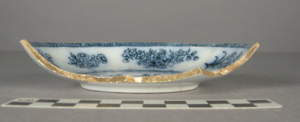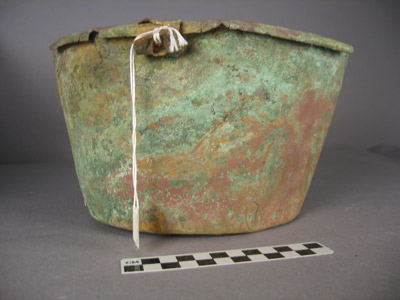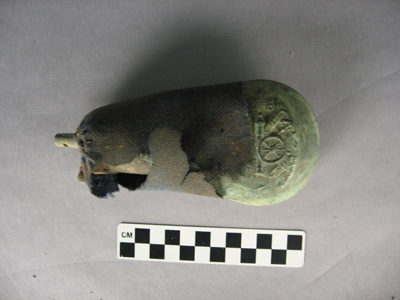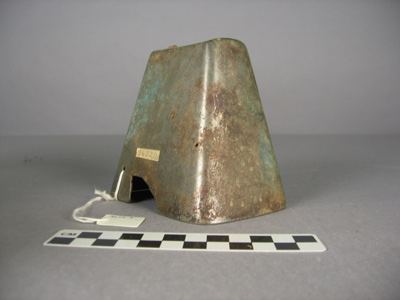A major milestone has recently been met by the Southern Oregon Historical Society. After 27 years of effort by various SOHS staff members, the Snavely collection ( Native American human remains and associated grave goods from the Little Applegate River) have been returned to Robert Kentta, Cultural Resources Program Representative for the Confederated Tribes of Siletz Indians on 11-20-2014.
 Sometime prior to 1952, human remains representing, at minimum, two individuals, were collected by O.N. Snavely from a site near the village of Buncom in Jackson County, OR. Mr. Snavely “found this grave while mining” on private land along the Little Applegate River, two miles from the confluence with the Big Applegate river at the mouth of Carberry Creek. In 1952, Mr. Snavely donated the human remains and associated funerary objects to the Southern Oregon Historical Society. The collection includes ten human teeth. No known individuals were identified. The 377 associated funerary objects include1 metate; 1 metal cowbell; 1 small metal cow bell; 1 metal powder flask; 1 rusted frying pan; 1 copper cooking pan; 1 piece of a broken china saucer; 1 white saucer; 4 fragments of a broken cup; 1 white inkwell with two fragments; 1 wood knife handle; 1 metal knife handle; 2 rusted tablespoons; 1 pocket watch in two pieces; 2 rusted bullet molds; 7 small bells; 1 pair of scissors in two pieces; 1 metal part with rings; 1 large knife with curved blade; 1 knife blade with beads attached; 2 gold rings; 8 shells; 97 dentalia shells; 4 uniform buttons; 5 separate bags of beads; 96 thimbles; 17 buttons of various sizes; 8 rusted metal rings; 1 elk tooth with a drilled hole; 86 white shell beads; 6 small glass medicine bottles and 22 pine nut beads.
Sometime prior to 1952, human remains representing, at minimum, two individuals, were collected by O.N. Snavely from a site near the village of Buncom in Jackson County, OR. Mr. Snavely “found this grave while mining” on private land along the Little Applegate River, two miles from the confluence with the Big Applegate river at the mouth of Carberry Creek. In 1952, Mr. Snavely donated the human remains and associated funerary objects to the Southern Oregon Historical Society. The collection includes ten human teeth. No known individuals were identified. The 377 associated funerary objects include1 metate; 1 metal cowbell; 1 small metal cow bell; 1 metal powder flask; 1 rusted frying pan; 1 copper cooking pan; 1 piece of a broken china saucer; 1 white saucer; 4 fragments of a broken cup; 1 white inkwell with two fragments; 1 wood knife handle; 1 metal knife handle; 2 rusted tablespoons; 1 pocket watch in two pieces; 2 rusted bullet molds; 7 small bells; 1 pair of scissors in two pieces; 1 metal part with rings; 1 large knife with curved blade; 1 knife blade with beads attached; 2 gold rings; 8 shells; 97 dentalia shells; 4 uniform buttons; 5 separate bags of beads; 96 thimbles; 17 buttons of various sizes; 8 rusted metal rings; 1 elk tooth with a drilled hole; 86 white shell beads; 6 small glass medicine bottles and 22 pine nut beads.
In 1987 the Snavely Collection was deaccessioned from the museum’s collection, as required by Oregon House Bill 3196, ‘1981’. In addition, the 1990 Federal Native American Graves Protection and Repatriation Act (Public Law 101-601; 25 U.S.C. 3001-3013) described the rights of Native American Indian tribes with respect to the treatment, repatriation, and disposition of Native American human remains, funerary objects, sacred objects, and objects of cultural patrimony, with which they could show a relationship of cultural affiliation. One major purpose of this statute (Sections 5-7) was to require that museums receiving Federal funds inventory holdings of Native American human remains and funerary objects and provide written summaries of other cultural items. The museums were required to consult with Indian Tribes to reach agreements on the repatriation of these remains and objects. Once cultural affiliation has been established, and in some cases the right of possession also has been demonstrated, affiliated Indian Tribes normally make the final determination about the disposition of cultural items. Disposition may take many forms from reburial to long term curation, according to the wishes of the culturally affiliated Tribe(s).
About The Southern Oregon Historical Society: Since its inception in 1946, the Southern Oregon Historical Society has collected, preserved and shared photographs and documents that reflect the lives of Rogue Valley residents. The Archives include many pioneer stories, but also those of later settlers, and of people born and raised in the Valley. The mission of SOHS is to make history come alive by collecting, preserving, and sharing the stories and artifacts of our common heritage. For more information call, 541-773-6536 or www.sohs.org.
Snavely Collection Photos Courtesy of Southern Oregon Historical Society



